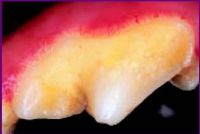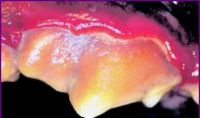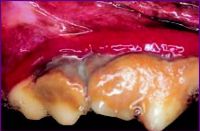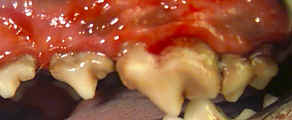Dental Care
An often overlooked aspect of pet care is maintaining healthy teeth and gums. Oral disease is the most diagnosed health problem for dogs and cats visiting veterinary offices today. Studies show that by age three, 80% of dogs and 70% of cats show signs of gum disease. Gum disease, also called gingivitis, can cause your pet pain, possible loss of teeth, and the bacterial infection in the gum tissue can enter your pet's bloodstream and affect vital organs such as the heart, liver, lungs, and kidneys.
We carry specially formulated dental diets for your dog or cat that can help reduce the accumulation of tartar and calculus. Speak with your veterinarian, or any other member of our medical team for more information on these diets.
THE STAGES OF DENTAL DISEASE
MILD

Mild (Stage 1) dental disease involves swollen gums (gingivitis). There is also usually a thin yellowish film covering the teeth, called plaque.
MODERATE

Moderate (Stage 2) dental disease, or perodontitis, is where the gums are very red and swollen, and may even bleed. The teeth have a darker, thicker film called calculus or tartar, and there may be early signs of gum recession. There may also be soreness of the mouth, and bad breath (halitosis).
SEVERE


Severe (Stages 3 and 4) periodontitis is where bacteria start to invade and destroy the affected gum, tooth, and bone tissue. There is severe gum recession, and bacteria can even start to spread throughout the entire body and organs via the bloodstream. By the 4th stage, there may be a significant amount of tooth loss.
The American Veterinary Dental Society recommends the following three step plan to help you maintain good oral health for your pet:
- Have your pet examined by a veterinarian. As a part of your pet's physical exam, the teeth will be examined for signs of infection. If there is a problem, a dental cleaning may be recommended. Even when a small amount of tartar is present on the teeth, gum infection has already begun.
- Start a dental care routine at home. Removing plaque and tartar regularly is an important part of dental disease prevention. We can suggest steps and show procedures on how to keep your pet's teeth clean. There are even specifically formulated diets for your dog and cat to reduce the accumulation of plaque and tartar. We will be glad to help you design a dental care plan that will work for you and your pet.
- Take your pet for regular veterinary dental check ups. Plaque builds up continuously on your pet's teeth. Regular check ups will allow us to monitor the progress of your preventative dental care routine and assure that any problems with your pet's teeth are addressed in a timely manner.
This email address is being protected from spambots. You need JavaScript enabled to view it.
